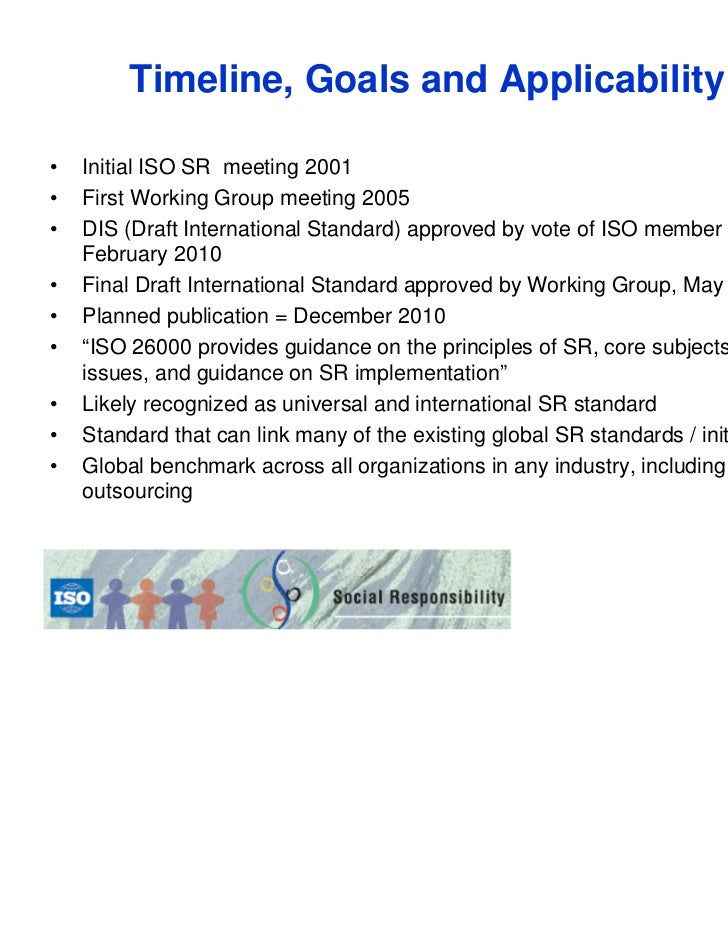Iso 26000 Standard
ISO 26000 was developed by 450 experts from 99 countries and 40 international organisations during 5 years. Ln 2010, after close to 25 000 written comments had been resolved, the standard was published in consensus. The standard offers more than 400 recommendations to any company or organization that wants to improve their contribution to sustainable environmental, social, and economic development. How is the standard being used? More than 80 countries have adopted ISO 26000 as a national standard and made it available to the national market. 20 more countries are in progress.
What are some of the supporting initiatives? How does it relate to other standards? ISO26000.info is an attempt to compile ISO 26000 related information and the website is free to use without any restrictions.
It is, however, up to the reader to verify the information before making references. All readers are invited to contribute with information and improvements.
ISO 26000 Guidance on social responsibility is launched from ISO, the. Is an International Standard providing guidelines for (SR) named ISO 26000 or simply ISO SR.
It was released on 1 November 2010. Its goal is to contribute to global, by encouraging business and other organizations to practice social responsibility to improve their impacts on their workers, their natural environments and their communities. This standard was developed by ISO/TMBG Technical Management Board - groups. ISO 26000 was published for the first time in November 2010. Contents. Main requirements of the standard The ISO 26000 adopts the structure in the following breakdown:.
Social Responsibility ISO 26000. The BSI website uses cookies. Buy copies of the ISO 26000 standard and supporting materials at the BSI Shop. How can the answer be improved?
1. Terms and definitions. 3.
Understanding social responsibility. 4. Principles of social responsibility. 5. Recognizing social responsibility and engaging stakeholders. 6.
Watch pass the light 2015 full movie. Guidance on social responsibility core subjects. 7. Guidance on integrating social responsibility throughout an organization.
Voluntary Guidance Standard for All Organizations ISO 26000 offers guidance on socially responsible behavior and possible actions. There are three ways it is different from the more widespread standards designed for companies to use to meet particular requirements for activities such as manufacturing, managing, accounting and reporting.
1) ISO 26000 is a voluntary guidance standard- that is, it does not contain requirements such as those used when a standard is offered for 'certification'. There is a certain learning curve associated with using ISO 26000, because there is no specific external reward - certification - explicitly tied to ISO 26000. ISO recommends that users say, for example, that they have 'used ISO 26000 as a guide to integrate social responsibility into our values and practices.' 2) ISO 26000 is designed for use by all organizations, not only businesses and corporations. Organizations, such as hospitals and schools, charities , etc.
Are also included. ISO 26000 makes particular efforts to show that its flexibility means that it can be applied by small businesses and other groups as well So far, many of the earliest users of ISO 26000 have been multi-national corporations, especially those based in Europe, and East Asia, particularly Japan. 3)ISO 26000 was developed through a multi-stakeholder process, meeting in eight Working Group Plenary Sessions between 2005 and 2010, with additional committee meetings and consultations on e-mail throughout the five-year process. Approximately five hundred delegates participated in this process, drawn from six stakeholder groups: Industry, Government, NGO (non-governmental organization), Labour, Consumer, and SSRO (Service, Support, Research and Others - primarily academics and consultants).
Leadership of various task groups and committees was 'twinned' between 'developing' and 'developed' countries, to ensure viewpoints from different economic and cultural contexts. Since ISO operates on a parliamentary procedure form based on consensus, the final agreed-on standard was the result of deliberation and negotiations; no one group was able to block it, but also no one group was able to achieve its objectives when others strongly disagreed. The goal was to make ISO 26000 accessible and usable by all organizations, in different countries, precisely because it reflects the goals and concerns of each and all of the stakeholder groups in its final compromise form.
ISO Box 3, 'ISO 26000 and small and medium-sized organizations(SMOs). ISO Clause 1, p. 1. E.g., Hahn, R. In: IEEE - Transactions on Engineering Management:. For a largely positive assessment see e.g., Hahn, R. In: IEEE - Transactions on Engineering Management.
A largely pessimistic view can be found in, for example, Schwarz, B. & Tilling, K. In: Corporate Social Responsibility and Environmental Management:. Henriques, Adrian (2012-01-05). The Guardian (UK). Retrieved 28 August 2017. Guertler, Guido (July 2013).
Is ISO 26000 Ready for Revision?. Retrieved 28 August 2017. Brett, David (2015-02-17). Retrieved 28 August 2017. Armstrong and, J. Scott; Green, Kesten C. (1 December 2012).
Iso 26000 Certification Standards
Journal of Business Research. Retrieved 28 October 2014. In: Business and Society:.
For a detailed analysis of the ISO 26000 development process see Hahn, R. In: Business and Society: Further reading. 13 February 2007.

Iso 26000 Standard Free Download
Retrieved 24 August 2012. External links. —Guidance on social responsibility. —Technical Management Board - groups. Winter/Spring 2006.